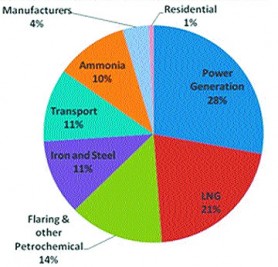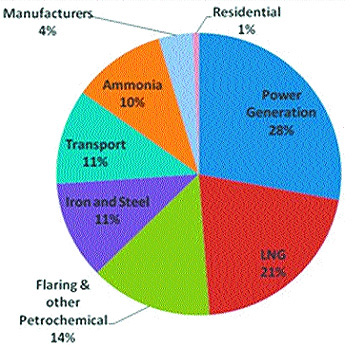By Haydn I Furlonge
Climate change is a reality. But is it caused by carbon dioxide (CO2)? There are few issues which have occupied the public space with the consistency and hype that have surrounded this one in recent years. It has become politically expedient in various circles to speak about these issues, without deference to the complexities involved. Even scientists and economists have widely divergent views, which one may easily gloss over in the wave of rising sensationalism. As such, it is worth considering both sides to the global warming storyline, its relation to climate change, and the role played by carbon dioxide. This article also explores the socio- economic implications for Trinidad and Tobago as a small island developing state that relies heavily on the burning of fossil fuels.
Greenhouse Gases and Global Warming

Let us first summarize the claims made in support of the impact of greenhouse gas (GHG) emissions on global warming. In simple terms, solar radiation enters the atmosphere and is re-radiated to outer-space by the surface of the earth. This process is hindered by the presence of certain gases which trap radiation in what is called the greenhouse effect. There is no dispute over this phenomenon, except the extent to which it contributes to global warming. It must be noted that such anthropogenic (i.e. man-made) GHGs include not just carbon dioxide (58%), but also halocarbons, and nitrous oxides. A common thread is that they are mostly produced from fossil fuels such as coal, crude oil and natural gas.
The first argument is whether GHGs, and by extension fossil fuels, are to blame for global warming. There is no denying that GHG levels have been increasing since the start of the industrial revolution. In fact, GHGs measured 280 parts per million (ppm) CO2 equivalent around the middle of the 19th century, compared to about 430 ppm today. With regard to global warming, the main measure is the globally averaged temperature anomaly (GATA). During this period, GATA has risen by 0.8 degrees Celsius, hence the global warming claim. This is often interpreted as causality between the increase in GHGs and global warming. However, there are other considerations. Water vapour and high clouds are thought to have a greater greenhouse effect than CO2, and these are driven not only by atmospheric temperature.
Secondly, the earth goes through natural cycles of cooling and warming. Given that the last little ice age occurred between the 15th and 19th centuries, a period of warming was not unexpected during the 20th century. The recent revelations about the truncation of temperature data sets by researchers at the University of East Anglia in computing GATA has, in an unsavoury way, served to cast doubt on the global warming argument. The furore over exaggerated projections on the melting rate of the Himalayan glaciers, made in a report by the highly influential Inter-governmental Panel for Climate Change (IPCC), has not helped the cause either.
Nonetheless, could the increase in GHGs and global warming over recent decades be somewhat coincidental? Climate models are developed in an attempt to seek some plausible scientific basis for the relationship between these two variables. Admittedly, computer simulations may not be entirely realistic given the various other parameters involved, and the complexity in their relationships, such as El Nino effects, solar flares, and oscillations in ocean temperatures. Therefore, whilst the corollary that GHGs is largely responsible for global warming remains unproven, it is safe to say that GHGs is one of the factors.
Global Warming and Climate Change
Let us now examine the distinction between climate change and global warming, to the extent that the latter is caused by CO2. Climate change is characterized for instance by variations in sea levels, coverage of polar ice caps and glaciers, and weather patterns. The increase in GATA (as an indicator of global warming) and the easily observable changes in the climate are often linked. Thus, the assumption often made is that global warming is driving climate change. Let’s examine this briefly.
Consider the claim proffered that the ice cap of Mount Kilimanjaro in Africa has been shrinking due to global warming, as highlighted in the popular film entitled “An Inconvenient Truth”, by former US Vice-President Al Gore. The explanation may seem logical. However, when one considers that the temperature at the surface of the ice cap remains well below its melting point, global warming cannot be responsible for any shrinkage. Research instead suggests that deforestation at the foothills of the mountain reduces the humidity of the winds up the slope thereby creating a disequilibrium between the natural evaporation and condensation processes leading to a reduction in ice mass. Closer to home, the correlation between global temperature and hurricane frequency and intensity is not as established as one might think. According to US National Oceanic and Atmospheric Administration (NOAA) the relationship may be actually inverse in some cases. In short, there are examples where the scientific link between global warming and climate change are accepted, and others where they are challenged or outright debunked.
So, what do we do?
Almost everyone would agree that using scientific uncertainty as a basis for inaction is untenable. This would be irresponsible in the context of sustainable development. What economic price and hardship should reasonably be borne now to avert social and environmental costs later on? In effect, the question is how much insurance premium should be paid for mitigating the risk of catastrophic effects from GHGs? A study by Sir Nicholas Stern (former World Bank chief economist) attempted to economically quantify the cost of inaction. Melting glaciers would affect one sixth of the world’s population, massive flooding would occur, coastlines recede, rainforests would dry up, and fifteen to forty percent of animal species would face extinction. The cost of dealing with such effects was estimated to be well over 5% of world GDP, which is more than what some countries spend on health care. On a unit basis, this is at least US$85 per tonne of CO2, which by way of comparison is about the cost of ammonia and methanol production. In other words, damage caused by the waste product of consuming fossil fuels can be as expensive as the cost of petrochemical production itself. By converting this cost to a present value basis, Stern found that it would be cheaper (at around US$ 25 per tonne of CO2 or about 1% of GDP) to mitigate CO2 emissions now.
We should qualify that the academic fraternity, not unexpectedly, has challenged Stern’s analysis. For instance one Harvard University professor questioned the use of unusually low discount rates which amplifies the cost to be faced by future generations to undo the effects of climate change today, when such costs are converted to a present value basis using the principle of the time value of money. Put another way, the assumptions by Stern increases the cost of mitigation today for the ill effects later on.
Implications for T&T
Clearly, climate science and economics are works in progress. Importantly, the fact is that the climate is changing in ways unprecedented. Bleaching of coral reefs, destruction of wetlands by encroaching sea water, erosion of beaches, high intensity hurricanes, excessive flooding, depletion of rain forests are some of the possible outcomes. That paints the picture of T&T as a victim. But has T&T been culpable as well. Do we contribute to our own demise?
A study conducted by UTT researchers estimated theoretical carbon dioxide emission levels from all major sources in T&T. Total emissions, net of that recycled for methanol production, was estimated at 23.4 million tonnes (mt) in 2007; see Figure for details. This takes into account natural sequestration via trees, amounting to about 2 mt per annum. Based on current planned energy projects and growth in other sectors, emissions will increase significantly to about 40 mt by 2012. On average, each citizen of this country either consumes or economically benefits from the consumption of fossil fuels to a greater extent than citizens from most other parts of the world. This results from the small population size and an economy that is heavily based on hydrocarbon exploitation. However, given that T&T contributes less than 0.1% of world annual emissions, it is unreasonable to use a per capita basis for imposing the degree of obligations (limits and penalties) as those of the major emitters such as China, USA, and European countries. For a small developing country, such regulations would have serious socio-economic implications.
Notwithstanding the aforementioned global warming debate, there is ample room for T&T to proactively “get its house in order”. There are several energy conservation and efficiency improvement opportunities to reduce GHGs, including reduced flaring in production activities, recycling boil-off gas at the LNG facility, integration of waste heat at the Point Lisas industrial estate, use of combined heat and power generation for greater fuel efficiency, phase-out of incandescent light bulbs, adoption of energy-efficient building codes, better transportation infrastructure to reduce traffic jams, and application of natural gas for air-conditioning and as a transport fuel. There are process technologies currently available which may reduce the carbon footprint of the country’s existing petrochemical, LNG and power plants without seriously compromising their viability.
Additionally, diversifying away from fossil fuels into renewable energy (RE) can significantly impact GHG emissions. This will not only introduce a level of long-term security to our energy supply, but also create sustainable jobs in an RE industry (e.g. equipment manufacture, installation and maintenance). Linkages with the agricultural sector for a biofuels industry may be developed, e.g. biodiesel and bioethanol from plants, and biomass for power generation. The challenge with RE implementation in T&T is of course the abundant and relatively cheap and subsidized natural gas for power generation and diesel/gasoline for transportation. It will take a widening of the economic envelope to include environmental and social benefits, and the opportunity cost of natural gas and oil derivatives which could otherwise be exported, to reveal win-win scenarios.
The Kyoto Protocol and Marrakech Accords provide business models for CO2 mitigation projects, such as the Clean Development Mechanism (CDM). Such projects may include the use of alternative fuels or energy sources (such as RE) which have lower carbon emission levels. The idea is that monetary value from the sale of “certified emissions reduction” (CER) credits to certain developed countries helps to make such projects viable. T&T is yet to avail itself of this opportunity.
There are mitigation efforts being made such as by the cement company, reforestation, and limited waste recycling; although, these amount to maybe 1 mt CO2 per annum. Any high impact reduction strategy must focus on the large emitters, such as power generation facilities, and LNG and petrochemical plants. One solution is capturing CO2 from process streams and storing it in underground reservoirs, such as saline aquifers or spent reservoirs; this is called carbon capture and geological storage (CCS). Feasibility and leakage risk studies are currently under investigation. Economic viability rests on its use in enhanced oil recovery (1 tonne CO2 may lift 1 barrel oil), appropriate fiscal regime, and CCS being declared a clean development mechanism (CDM) project for which certified emission reduction credits can be sold. Notwithstanding this, there are a few CCS projects in commercial operation around the world, e.g. in Algeria by BP.
The relevant government ministries in T&T are in the process of devising policy positions and strategies on climate change and RE. These have major implications for sustainable development of the country as pertains to our environment, ecosystems, energy security and economy. It must be noted that internationally acceptable standards for quantifying emissions, measuring and reporting must be adopted for CO2 mitigation technologies to be implemented. Indeed, the regulatory framework and State entities to govern and commercialize all of this, respectively, are yet to be put in place. Strategies must also be pursued to leverage financial and technological support from local stakeholders and the international community.
Reprinted from the Trinidad and Tobago Review

